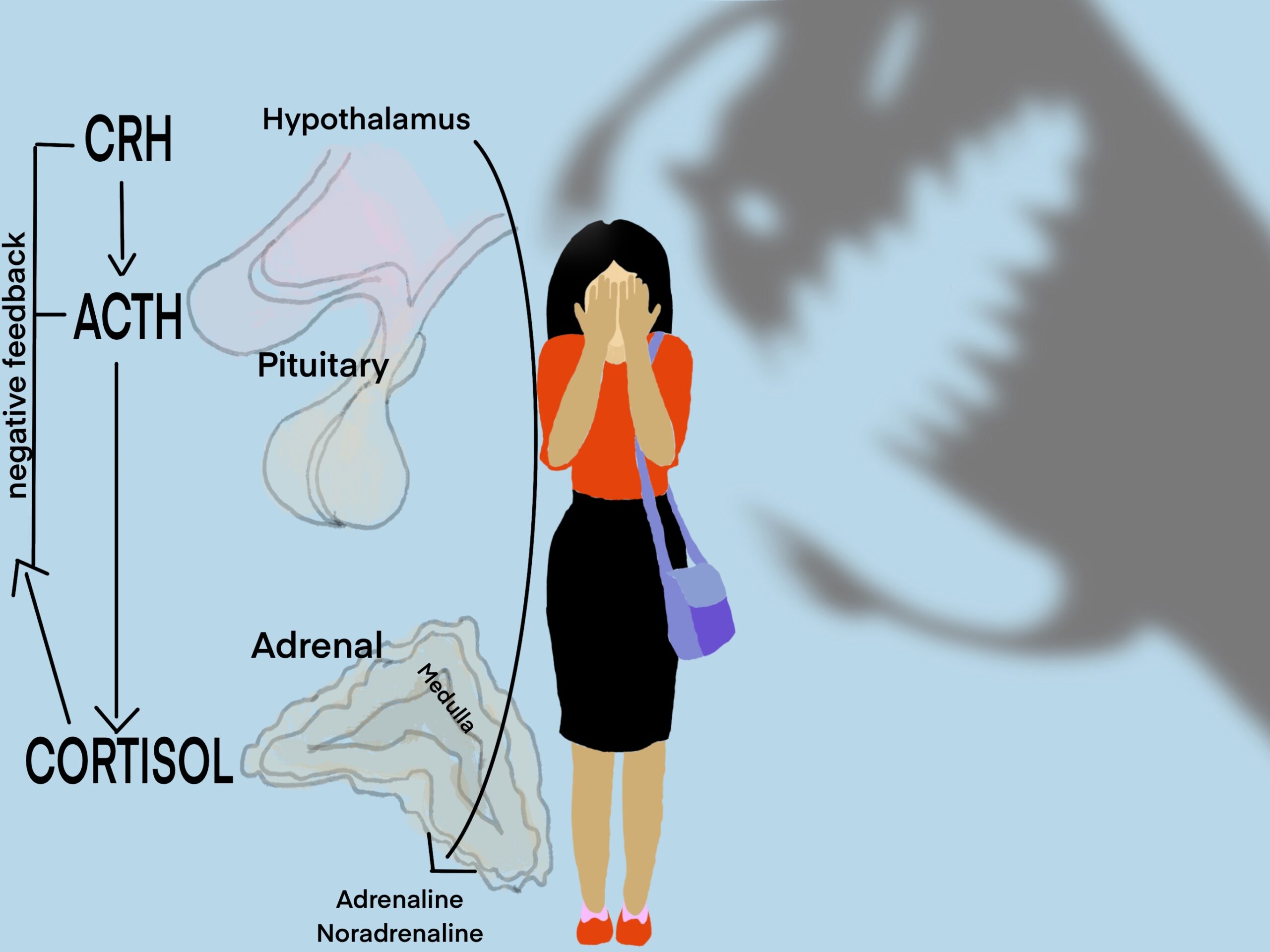My STEAM project covers the topic of the Endocrine System and discusses the objective of describing how hormones exert control over target cells and how feedback within these systems work during a fear response. The endocrine system collaborates with the nervous system to coordinate and integrate the activity of body cells; with the endocrine system using hormones released into the blood for activity and the nervous system using action potentials and neurotransmitters for activity. When an individual experiences a traumatic stress, a fear response is evoked which involves concurrent and instantaneous biological responses to aid and evaluate the measure of danger present, as well as their reaction (Yehuda, 2022). My art uses digital graphic media through use of my iPad and Apple pencil to depict a fear induced situation along with what hormones are involved during a stress and fear response.
Described as “fight or flight,” is the initial response of stress along with the increase of heart rate and blood pressure. The brain organ that provides an individual with their sensory experiences is called the amygdala. The amygdala essentially dictates whether there should be a stress response. If there is, it will initiate “neurochemical and neuroanatomical circuitry of fear,” and the process happens within milliseconds. Within these several milliseconds, the amygdala projects to the reticularis pontis caudalis which increases the effect of a startle response and commences defensive behaviors. The projection from the amygdala to the lateral hypothalamus, and afterward to the rostral ventral medulla, commences the sympathetic nervous system and catecholamine responses which have some amounts of neurotransmitters including epinephrine and dopamine. From there, projections from the amygdala to the solitary tract commence the parasympathetic responses and projections from the central amygdala to the bed nucleus of the stria terminalis commence the hypothalamic-pituitary-adrenal (HPA) axis response. (MedicinePlus, 2022; Yehuda, 2022).
When modulating stress or fear, the HPA axis is activated by the neuropeptides that stimulate the hypothalamus which release corticotropin releasing factor (CRF) hormone as well as other regulatory neuropeptides that stimulate the release of adrenocorticotropic hormone (ACTH), which also commence the adrenal gland to release cortisol (Yehuda, 2022).
The hormones of the HPA axis including cortisol, ACTH, and CRF are increased when a stressor that initiates fear is involved with higher levels of these hormones present when the stressor is greater (Steimer, 2002; Yehuda, 2022). But, these hormones also mediate the response to stress and fear. The catecholamine hormones integrate stored energy to the body’s vital organs and the cortisol functions to modulate and stop the sympathetic activation as well as other neuronal defensive actions that were stimulated due to stress and fear responses. Once fear and stress related responses start to stop due to the cortisol inhibiting these factors, high levels of cortisol also inhibit further release of cortisol. Through a negative feedback loop, cortisol acts on the brain regions that are responsible for the stimulation of cortisol hormone release and these are the pituitary, hypothalamus, hippocampus, and amygdala. Moreover, when there is no longer a stressor involved, a negative feedback loop through the HPA axis is commenced and normal hormone levels are reinstated (Yehuda, 2022).
References
“Adrenocorticotropic Hormone (ACTH): Medlineplus Medical Test.” MedlinePlus, U.S. National Library of Medicine, https://medlineplus.gov/lab-tests/adrenocorticotropic-hormone-acth/.
Steimer, T. (2002). The biology of fear- and anxiety-related behaviors. Dialogues in Clinical Neuroscience, 4(3), 231–249. https://doi.org/10.31887/DCNS.2002.4.3/tsteimer
Yehuda , Rachel. “Biology of Posttraumatic Stress Disorder – Psychiatrist.com.” Biology of Post-Traumatic Stress Disorder , 2022, https://www.psychiatrist.com/read-pdf/24037/.


Joerenz’s STEAM project analyzes how hormones in the endocrine system take control over target cells, and the feedback within these systems exhibited during a fear response. His compelling digital artwork depicts a person experiencing a fear induced situation and outlines the hormones that would be involved. Both the endocrine system and nervous system work in tandem during a stress or fear response by releasing hormones into the bloodstream, and using neurotransmitters to generate responses which serve to evaluate dangers present and the necessary actions to be carried out in response. “Fight or flight,” which happens in a matter of seconds, is the body’s initial response to situations involving fear or stress, followed by the increase of heart rate and blood pressure. The amygdala in the brain decides how to respond to these types of situations and will commence the sympathetic nervous system and catecholamine responses which produce epinephrine and dopamine. The hormones in the hypothalamic-pituitary-adrenal (HPA) axis such as cortisol, ACTH, and CRF increase when an indication of fear is present. When the body starts to sense fear and stress related responses decreasing due to the cortisol inhibiting these factors, it begins to inhibit further release of cortisol throughout the body. Through a negative feedback loop, cortisol acts on the pituitary, hypothalamus, hippocampus, and amygdala which are collectively responsible for the stimulation of cortisol hormone release. Once a fear or stressor is no longer active, a negative feedback loop through the HPA axis initiates, and hormone levels in the body return to normal.
Great job Joerenz!!!